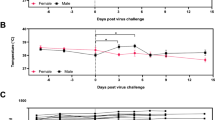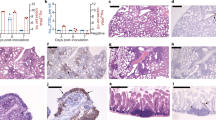There is now a choice of animal models for testing therapies against the human virus.
Abstract
The reservoir of the coronavirus isolated from patients with severe acute respiratory syndrome (SARS)1,2 is still unknown, but is suspected to have been a wild animal species. Here we show that ferrets (Mustela furo) and domestic cats (Felis domesticus) are susceptible to infection by SARS coronavirus (SCV) and that they can efficiently transmit the virus to previously uninfected animals that are housed with them. The observation that these two distantly related carnivores can so easily be infected with the virus indicates that the reservoir for this pathogen may involve a range of animal species.
Similar content being viewed by others
Main
Serological and virological studies have indicated that Chinese ferret badgers (Melogale moschata), masked palm civets (Paguma larvata) and raccoon dogs (Nyctereutes procyonoides) can be infected with a virus that is very similar to SCV (ref. 3). Domestic cats living in the Amoy Gardens apartment block in Hong Kong, where more than 100 residents contracted SARS last year, were also found to be infected with SCV.
To test the susceptibility of domestic cats and ferrets to SCV infection, we inoculated them intratracheally with 106 median tissue-culture infectious dose units (TCID50), which we obtained from patient 5688 (who died from SARS) and then passaged four times on Vero 118 cells4,5 in vitro. We then took nasal, pharyngeal and rectal swabs from the animals on different days post-infection (p.i.). Four animals from each group were killed at 4 days p.i. and were necropsied according to a standard protocol4,5.
No clinical signs were seen in SCV-inoculated cats, whereas three out of six ferrets became lethargic from days 2–4 p.i. and one of these ferrets died 4 days p.i. All cats (Fig. 1a) and ferrets (Fig. 1b) shed SCV from the pharynx, starting at 2 days p.i. and continuing until days 10 and 14, respectively, as demonstrated by polymerase chain reaction with reverse transcription (RT-PCR)5. The virus was isolated4,5 from all pharyngeal swabs taken on days 2–8 p.i. and from nasal swabs taken from two cats on days 4 and 6 p.i. SCV was not detected in nasal swabs from ferrets or in rectal swabs from cats or ferrets.
a, b, SCV titres per ml from cats (a) and ferrets (b) (n = 6 of each) that had been inoculated with SCV through the respiratory route. Four animals from each group were killed on the fourth day after infection, and two were kept until day 28. c, d, SCV titres from non-inoculated cats (c) and ferrets (d) (n = 2 of each) that had been housed with inoculated cats and ferrets, respectively. SCV excretion was quantified in pharyngeal swabs by using reverse transcription with the polymerase chain reaction, and was compared to a titrated SCV standard. ND, not determined.
Infection of the respiratory tract was evident in all animals tested: SCV was isolated from the trachea and lungs (see supplementary information). Quantification of the viral titres in lung homogenates revealed relatively low SCV titres (geometric mean ± s.d.) in the lungs of SCV-inoculated cats (1 × 103 ± 0.51 TCID50 ml−1) compared with those in ferrets (1 × 106 ± 0.70 TCID50 ml−1). Histologically, SCV infection was associated with pulmonary lesions similar to those seen in SCV-infected macaques4,5, except that they were milder, particularly in SCV-infected cats, and did not feature syncytia.
In the gastrointestinal and urinary tracts, SCV was detected by RT-PCR (see supplementary information). Follow-up of the remaining SCV-inoculated animals (n = 2 per group) revealed that they had all seroconverted5 by 28 days p.i. (neutralizing antibody titres of 40–320). Two attempts to infect suckling mice through intracerebral inoculation failed.
Non-inoculated cats (Fig. 1c; n = 2) and ferrets (Fig. 1d; n = 2) that were housed with the inoculated cats and ferrets, respectively, became infected with SCV: viral titres gradually increased from 2 days p.i. onwards, peaking at days 6–8 p.i. Neither of the cats showed clinical signs of infection, but both had seroconverted by day 28 (they had virus-neutralizing antibody titres of 40 and 160, respectively). Both ferrets were lethargic and developed conjunctivitis; they died on days 16 and 21 p.i. We established by pathological examination that the main lesions in both animals were marked hepatic lipidosis and emaciation. There was no evidence that either of these animals died from SCV-associated pneumonia, although SCV was isolated from post-mortem lung specimens of one animal.
Our results show that ferrets and domestic cats are susceptible to experimental infection by SCV, and that the virus is efficiently transmitted to animals living with them. These species might therefore be useful as animal models to test antiviral drugs or vaccine candidates against SARS.
References
Ksiazek, T. G. et al. N. Engl. J. Med. 348, 1953–1966 (2003).
Peiris, J. S. M. et al. Lancet 361, 1319–1325 (2003).
Guan, Y. et al. Science 302, 276–278 (2003).
Fouchier, R. A. M. et al. Nature 423, 240 (2003).
Kuiken, T. et al. Lancet 362, 263–270 (2003).
Author information
Authors and Affiliations
Corresponding author
Ethics declarations
Competing interests
The authors declare no competing financial interests.
Supplementary information
Rights and permissions
About this article
Cite this article
Martina, B., Haagmans, B., Kuiken, T. et al. SARS virus infection of cats and ferrets. Nature 425, 915 (2003). https://doi.org/10.1038/425915a
Issue Date:
DOI: https://doi.org/10.1038/425915a
This article is cited by
-
Care, management, and use of ferrets in biomedical research
Laboratory Animal Research (2024)
-
Animal experiments on respiratory viruses and analogous studies of infection factors for interpersonal transmission
Environmental Science and Pollution Research (2023)
-
An Overview on the Zoonotic Aspects of COVID-19
Proceedings of the National Academy of Sciences, India Section B: Biological Sciences (2023)
-
Susceptibility of domestic and companion animals to SARS-CoV-2: a comprehensive review
Tropical Animal Health and Production (2023)
-
Evaluation of the clinical evolution and transmission of SARS-CoV-2 infection in cats by simulating natural routes of infection
Veterinary Research Communications (2022)
Comments
By submitting a comment you agree to abide by our Terms and Community Guidelines. If you find something abusive or that does not comply with our terms or guidelines please flag it as inappropriate.




